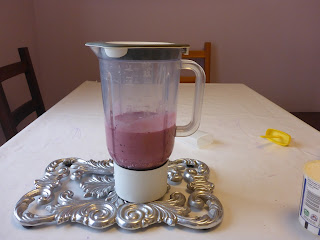For a truly budget popsicle, try using the juice left over from tinned fruit. Or incorporating that in the mix! But if you are a good foragers, there's no reason to stop there. We get tons of brambles in the autumn and often have a few old bananas lying around that want using up!
Ingredients:
200g blackberriesbanana
1 freshly pealed and chopped apple (or an orange, melon, whatever you have)
Method:
Place the food processor or a blender with a metal blade.Whizz.
Pour into molds and freeze overnight.
Layered Ice Lollies
We sometimes do it in 2 steps to get a layered effect!
Hot pink layer - was cranberry juice whizzed with raspberries and gooseberries
White layer - double cream beaten with mascarpone cheese and 100g icing sugar. Clearly not a budget choice but we had leftovers from Burns Night cranachan which needed using up! Any ice cream could be substituted.
Purple layer - see the above recipe with brambles
 |
| Three layers' origins |


















